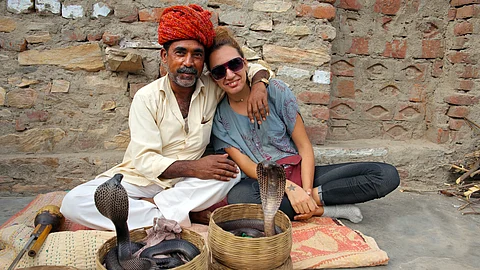
- Destinations
- Experiences
- Stay
- What's new
- Celebrating People
- Responsible Tourism
- CampaignsCampaigns
- Subscribe
- Buy Now

Located 200 km southeast of Pune in Maharashtra’s Solapur district lies Shetphal (also Shetpal), India's extraordinary “snake village” where an age-old covenant with cobras defines everyday life.
Shetphal offers more than a peculiar sight—it’s a powerful lesson in coexistence. Here, people have integrated religious symbolism, practical tolerance, and ecological understanding to live harmoniously with one of India’s most feared creatures. It stands as a living testament to faith, fearlessness, and cultural resilience.
Each of the village’s residents welcomes snakes—especially cobras—into their homes, not as intruders but as revered guests. Every house has a devasthanam, a dedicated alcove or hollow in the rafters, where snakes can enter, rest, and receive offerings like milk, grains or vermilion. Villagers see these reptiles as living embodiments of divine energy tied to Nag deities and Lord Shiva.
Remarkably, a snakebite has never been reported in Shetphal despite cobras freely roaming homes, classrooms, schools, and shops. From toddlers to elders, humans and snakes coexist—with children even playing near or with them without fear.
The spiritual core of Shetphal lies in its daily worship and grand celebrations during Nag Panchami (July/August), when villagers offer milk, sweets, and prayers to the snake gods and cobra idols. The local Siddheshwar temple is believed to cure snakebites, with historical records claiming around 100 victims were treated successfully.
This deep respect has far-reaching effects: snakes feel welcome, nest, and thrive, while people have learned their behaviours, reducing chances of conflict. It’s a model of biocultural coexistence and informal conservation. In recent years, Shetphal has garnered attention as an emerging ecotourism destination embedded in spiritual and cultural authenticity
Getting There: It is about a four‑hour drive from Pune; the nearest railheads are Baramati or Katphal.
Best time to go: Late spring to monsoon—snakes are most visibly active.
What to expect: Guided village walks, seeing cobras in sacred Devasthanams, observing Nag Panchami rituals (if you visit during Shravan), and visiting the Siddheshwar temple.
